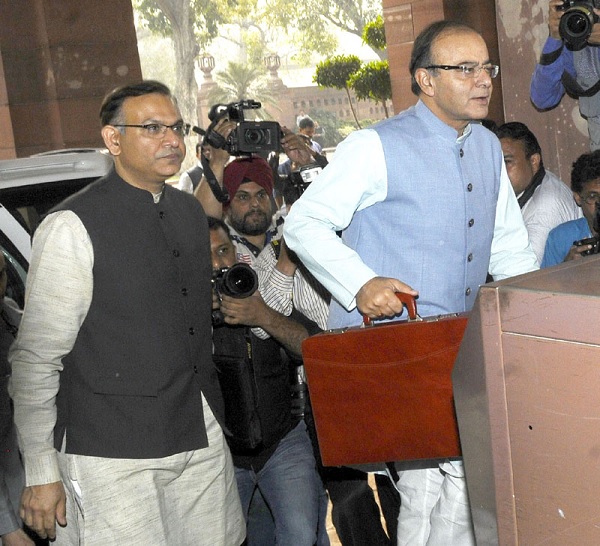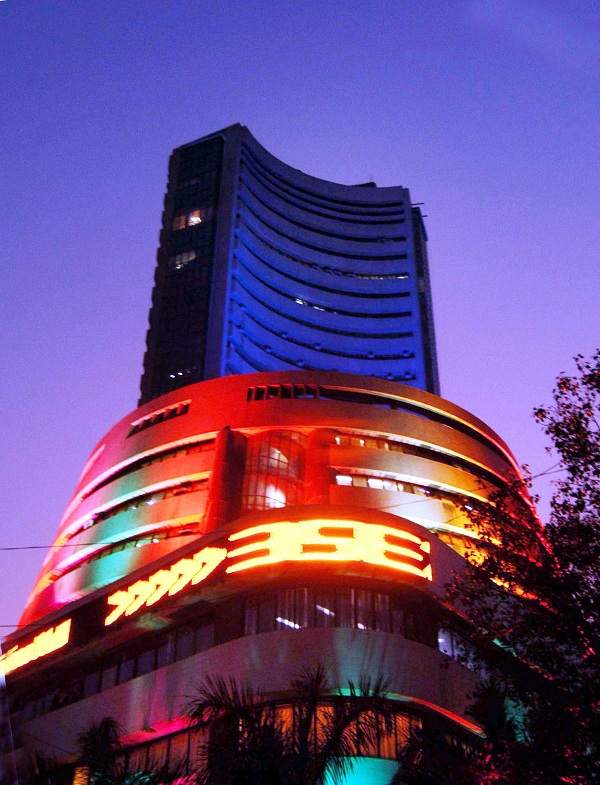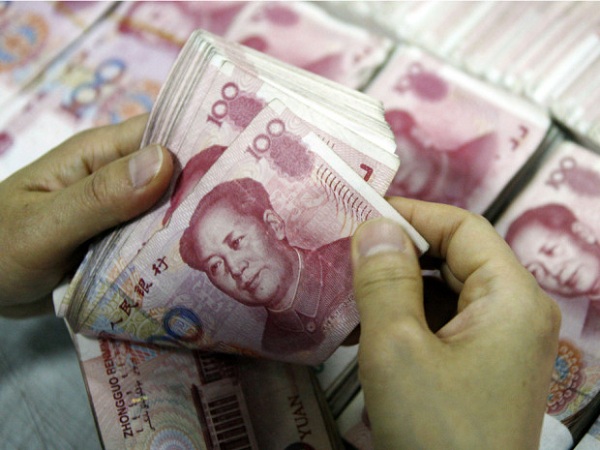
by Editor | May 25, 2021 | Corporate, Corporate Governance, Finance, News
 Mumbai:(IANS) Union Budget announcements, combined with negative Asian cues, and a dip in the rupee value depressed the Indian equity markets during the afternoon trade session on Monday.
Mumbai:(IANS) Union Budget announcements, combined with negative Asian cues, and a dip in the rupee value depressed the Indian equity markets during the afternoon trade session on Monday.
Consequently, the barometer 30-scrip sensitive index (Sensex) of the Bombay Stock Exchange (BSE) plunged by over 151 points.
Similarly, the wider 50-scrip Nifty of the National Stock Exchange (NSE) traded in the red. It was lower by 62 points or 0.88 percent to 6,968.15 points.
The Sensex, which opened at 23,238.50 points, traded at 23,002.77 points (at 12.00 p.m.) — down 151.53 points or 0.65 percent from the previous day’s close at 23,154.30 points.
During the intra-day trade so far, the Sensex touched a high of 23,293.80 points and a low of 22,956.80 points.
Vaibhav Agarwal, vice president and research head at Angel Broking, elaborated that markets traded on a negative note, led by mixed Asian cues and cautiousness prevailing around the budget.
“Expectations continue to remain low with markets not having witnessed any pre-budget rally this year.”
Nitasha Shankar, senior vice president for research with YES Securities said: “Markets eagerly watch out for an increased spending in the infrastructure space, road map to bank recapitalisation and a rural thrust.”
“Along with this it will be crucial for the finance minister to strike a right balance between growth and fiscal consolidation.”
The Union Minister for Finance, Corporate Affairs and Information & Broadcasting, Arun Jaitley departs from North Block to Parliament House along with the Minister of State for Finance,Jayant Sinha to present the General Budget 2016-17, in New Delhi on February 29, 2016.

by Editor | May 25, 2021 | Opinions

Bombay Stock Exchange
By Rohit Vaid
Mumbai:(IANS) Disappointment over earning results, combined with negative global cues and a weak rupee dragged the Indian equity markets to their lowest levels in over 21 months during the just-concluded weekly trade.
Indian equity markets declined for four consecutive sessions to post their biggest weekly loss since July, 2009.
Weak crude oil prices amid negative global indices and discouraging international macro-economic data, painted a grim picture for investors.
Despite some recovery on Friday due to short-covering, both the bellwether indices ended the week below the psychologically important levels of 23,000 and 7,000-point marks, respectively.
The barometer 30-scrip sensitive index (S&P Sensex) of the Bombay Stock Exchange (BSE) plunged by 1,630.85 points or 6.62 percent to 22,986.12 points.
Similarly, the wider 50-scrip Nifty of the National Stock Exchange (NSE) receded by 508.15 points or 6.78 percent to 6,980.95 points.
Sector-wise, realty index depleted by more than 11 percent, followed by capital goods index which dived by 8.8 percent, metals index plummet by 8.2 percent and oil and gas index was down by 8.1 percent.
Global indices, too, took a beating with the Nikkei losing 11 percent, while the Hang Seng was down five percent. The French CAC and London’s FTSE lost between 4-5 percent.
“Markets ended the week sharply in the red with deep cuts witnessed in first four sessions this week,” Vaibhav Agarwal, vice president and research head at Angel Broking, told IANS.
“The weakness was largely on account of global headwinds such as growth concerns, fall in crude prices and issues in the banking sector.”
Nitasha Shankar, vice president for research with YES Securities, specifically cited that broader markets slumped due to heavy selling in the mid and small cap space.
“Banking index continued to slide southwards, witnessing massive declines after weak earnings report from the PSU banks,” Shankar elaborated.
“Market defensives like pharma, FMCG and IT stocks came under severe pressure as selling was seen across all major sectors. Telecom, however, ended in the green providing some support to the index.”
Further, volatile crude oil prices flared volatility through-out the week under review.
In addition, the selling frenzy by foreign investors, not only dampened equity markets sentiment, but also drowned rupee’s value.
Dhruv Desai, director and chief operating officer at Tradebulls, noted: “Foreign institutional investors selling in the absence of buying has hurt prices even more.”
“The European market spreading negative impact to all Asia and continuing bad US jobless data, crude oil fall increase the chances to interest rate rise.”
On a weekly basis, the rupee weakened by 59 paise to 68.23-24 (February 12) against a US dollar from its previous close of 67.64-65 to a greenback (February 5).
On Friday, the Indian rupee touched its lowest level since early September 2013 at 68.47 mark on the spot market.
“The global-risk off sentiment, low demand, weak investment and tightening of US monetary policy, coupled with Chinese economic woes have all impacted the rupee value during the last week,” Anindya Banerjee, associate vice president for currency derivatives with Kotak Securities, told IANS.
The weakness in the India rupee’s value indicates the massive outflow of foreign funds from the equity and debt markets.
The National Securities Depository Limited (NSDL) figures showed that the FPIs (Foreign Portfolio Investors) sold Rs.3,860.62 crore or $568.22 million in the equity and debt markets from February 8-12.
The data with stock exchanges disclosed that the FPIs divested stocks worth Rs.3,027.62 crore during the week under review.
Conversely, the data showed that domestic institutional investors (DIIs) bought stocks worth Rs.2,069.46 crore.
Nevertheless, the markets stabilised somewhat and closed on a flat-to-positive note on Friday.
The minute gains were made on account of short-covering, value buying and strengthening of crude oil prices.
(Rohit Vaid can be contacted at rohit.v@ians.in)

by Editor | May 25, 2021 | Economy, News

Bombay Stock Exchange
By Rohit Vaid
Mumbai:(IANS) Hopes of an interest rate cut, combined with dovish monetary policies in the US and Japan, buoyed the Indian equity markets during the just-concluded weekly trade.
Even the rebound in global crude oil prices, additional liquidity injected by the Chinese central bank and the healthy buying by domestic investors supported the gains made by the equity markets.
However, the rupee’s continuous slide prompted by foreign investors’ selling frenzy capped gains.
The barometer 30-scrip sensitive index (S&P Sensex) of the Bombay Stock Exchange (BSE) closed higher by 435.03 points or 1.78 percent to 24,870.69 points.
Similarly, the wider 50-scrip Nifty of the National Stock Exchange (NSE) gained by 141.1 points or 1.90 percent to 7,563.55 points.
Markets made substantial gains on Friday, as investors were seen hopeful for an interest rate cut during the upcoming monetary policy review by the Reserve Bank of India (RBI), which is slated for February 2.
Expectations were backed up by the Bank of Japan’s (BoJ) decision to go in for a negative interest rate to support the Japanese economy.
The Japanese central bank cut it’s key lending rates by 20 basis points to negative 0.1 percent. The decision came after the US Fed maintained its status quo on key lending rates.
Recently, the European Central Bank (ECB) indicated more stimulus measures which will be announced in March.
“Markets rose on the back of short-covering and value buying. The rise was also on account of hopes for an interest rate cut by the RBI and strength seen in the rupee’s value on Friday,” Anand James, co-head, technical research desk with Geojit BNP Paribas Financial Services, told IANS.
“The continuation of stimulus by BoJ, following US Fed’s status quo on interest rates has heightened expectations of an interest rate cut by the RBI.”
Vaibhav Agarwal, vice president and research head at Angel Broking, said: “Markets ended the week on a strong note after the surprise move by the BoJ to push interest rates into negative territory and the F&O expiry out of the way.”
“Most global markets and commodities ended Friday with strong gains led by the move, resulting in a positive closing for the week. The US Fed chair also kept interest rates unchanged at the FOMC meet in line with expectations.”
In addition, stiffening of crude oil prices, which edged-up over $30-level from lows of $26-mark accelerated buying activity.
“The oil price jumped significantly last week and held higher as the first concrete signs that volatility may come down,” noted Dhruv Desai, director and chief operating officer at Tradebulls.
Notwithstanding equity gains, a weak rupee dented investors’ risk taking appetite.
On a weekly basis, the rupee weakened by 16 paise at 67.78-79 (January 29) to a US dollar from its previous close of 67.63 to a greenback (January 22).
However, it touched a new 29-month low of 68.23 to a US dollar — its weakest level since late August, 2013 during the intra-day trade on January 28.
The weakness in the rupee value indicated the massive outflow of foreign funds from the Indian equity and debt markets.
The National Securities Depository Limited (NSDL) figures showed that FPIs (Foreign Portfolio Investors) were net sellers during the week ended January 29, 2016. They divested Rs.1,203.64 crore or $177.55 million in the equity and debt markets from January 25-29.
Similarly, data with stock exchanges disclosed that the FPIs sold stocks worth Rs.848.2 crore in the week under review.
The FPIs have been net sellers in every trading session with exception of January 1, 2016. In total FIIs have sold equities worth Rs.13,966 crore during January.
Nevertheless, the data further showed that DIIs bought stocks worth Rs.1,807.86 crore.
DIIs have bought equity worth Rs.22,240 crore for January.
Markets made gains despite below-expected quarterly numbers from majors like ICICI and Bharti Airtel.
“Unfortunately, all the optimism on global factors can not hide the fact that earnings reported by some of the key and large Indian corporates have not been good despite low expectations from 3Q (Third Quarter),” pointed-out Pankaj Sharma, head of equities for Equirus Securities.
“These include ICICI Bank and Bharti Airtel. Also, some of the latest trends on capacity utilisation, new orders and inventory pile up as reflected in RBI’s survey are also disappointing.”
(Rohit Vaid can be contacted at rohit.v@ians.in)

by Editor | May 25, 2021 | World

Photo Credit: FinancialExpress
Mumbai:(IANS) Negative cues eminating out of China coupled with bearish equity markets resulted in the rupee falling to its lowest levels against the US dollar in over two years during the intra-day trade on Monday.
The Indian currency was trading at 66.83 to a dollar at 4.00 p.m., down 37 paise from its previous close of 66.46 on Friday (September 4, 2015). The rupee had touched an intra-day high of 66.85.
The rupee had last breached the 66.80-level to a greenback on September 4, 2013.
The Indian currency came in for a beating as frantic dollar-buying in China devalued the off-shore yuan and other Asian currencies, including the rupee.
The volatility started after reports from China suggested that the central bank there was planning to impose stringent regulations on foreign exchange purchases from October to curb speculation and volatility.
Interestingly, the Chinese yuan was two percent weaker in off-shore markets than domestically.
“The rupee is being impacted from the pressure put on yuan (devaluation) and the expected shortfall of dollars in China due to the reports on new regulations,” Anindya Banerjee, associate vice president for currency derivatives with Kotak Securities explained to IANS.
“The macro data on foreign reserves from China suggest there has been a huge outflow of funds despite direct investments and exports.”
The rupee’s downward spiral also impacted the barometer index of the Indian equity markets the 30-scrip sensitive index (Sensex) of the Bombay Stock Exchange (BSE) which plunged by over 308 points or 1.22 percent at close of trading on Monday.
Investor confidence was eroded on the back of fears of an interest rate hike in the US, weak monsoon and bearish Asian markets.

 Mumbai:(IANS) Union Budget announcements, combined with negative Asian cues, and a dip in the rupee value depressed the Indian equity markets during the afternoon trade session on Monday.
Mumbai:(IANS) Union Budget announcements, combined with negative Asian cues, and a dip in the rupee value depressed the Indian equity markets during the afternoon trade session on Monday.

